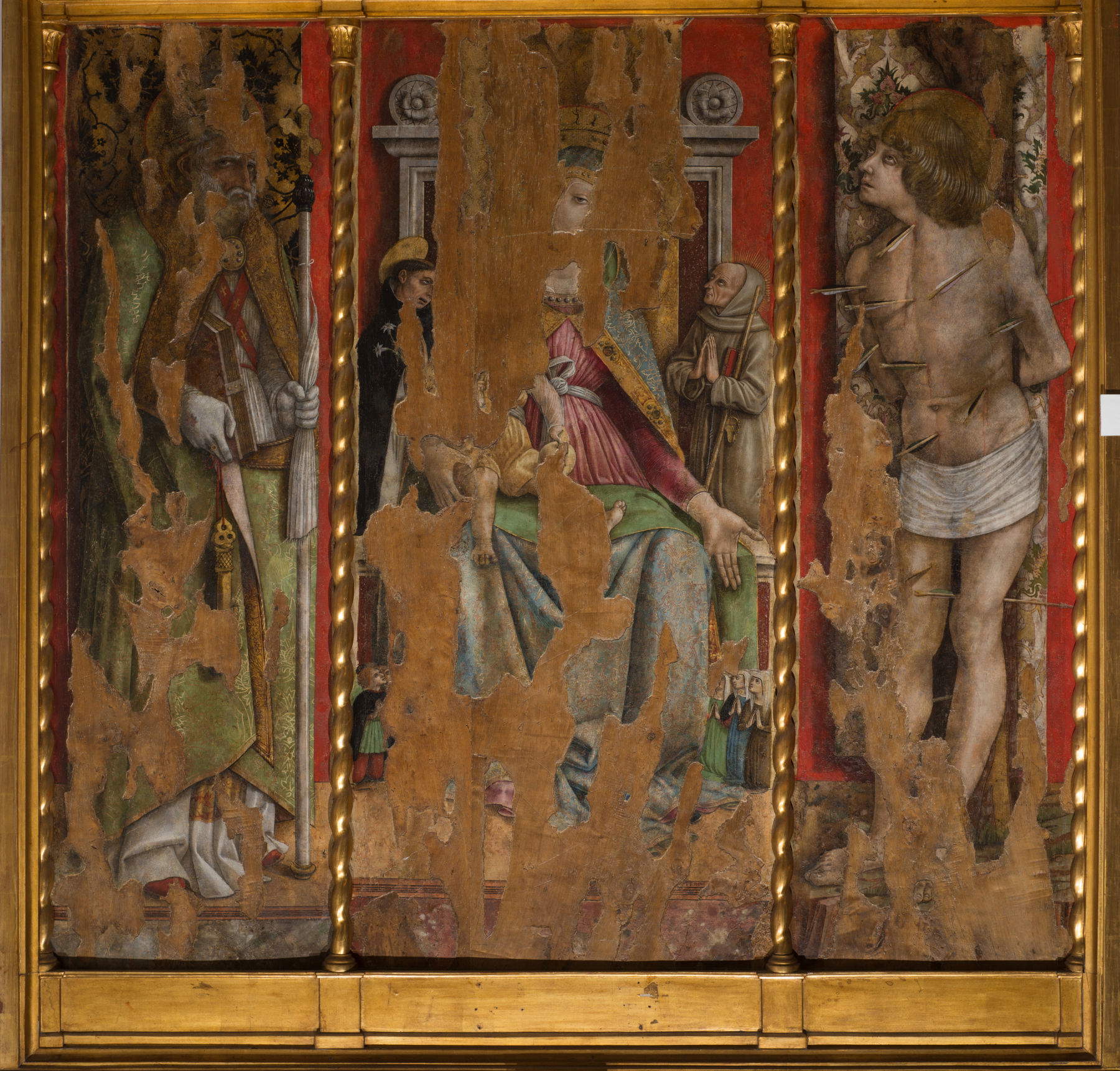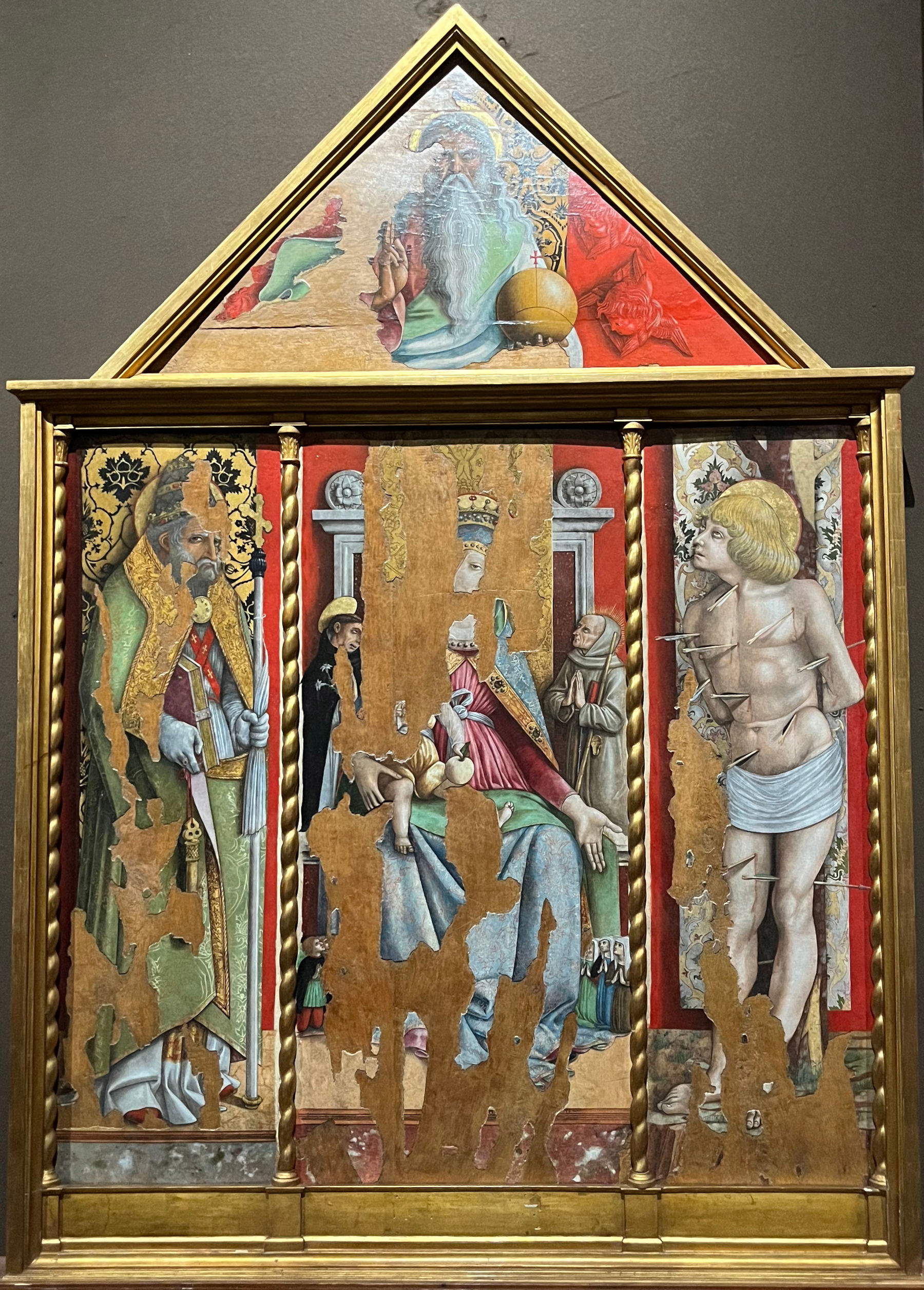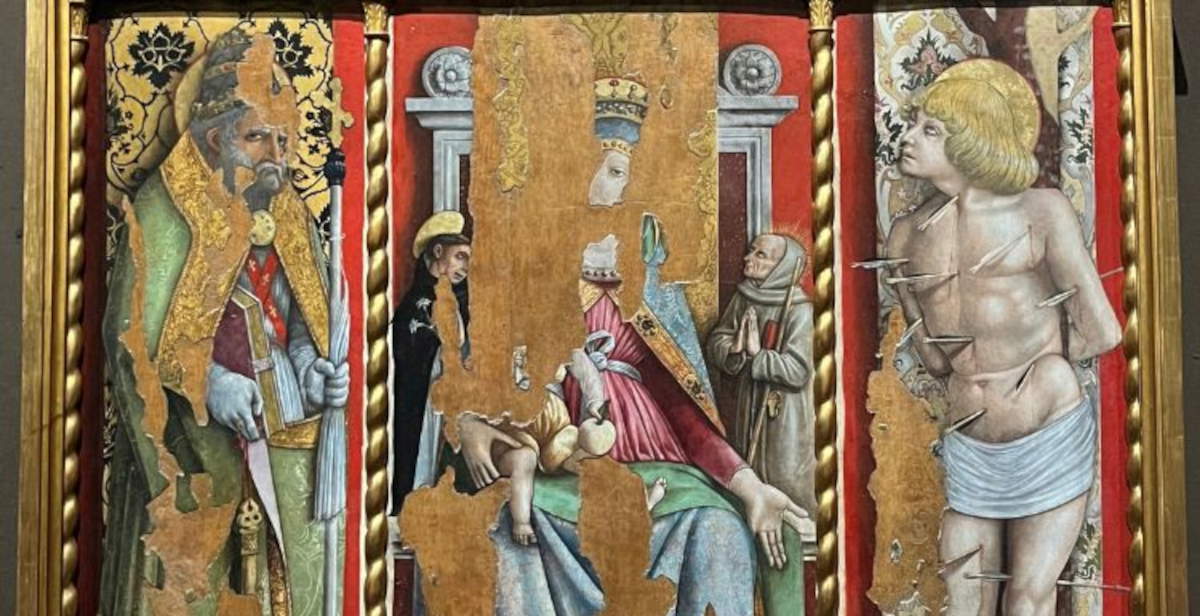After more than six months of work, the restoration of the First Triptych of Valle Castellana by Carlo Crivelli (Venice, c. 1430-1435 - Ascoli Piceno, c. 1495), housed at the Pinacoteca Civica di Ascoli Piceno, has been completed. The intervention marks the eighth and final stage of the project La natura nel cuore di..., an initiative to enhance the Italian artistic heritage promoted by Rigoni di Asiago in collaboration with Fondaco Italia. The project, launched in 2015 on the occasion of Expo Milano, celebrates ten years of activity in 2025.
With the operation, Rigoni di Asiago symbolically closes a path that lasted a decade, during which eight restoration projects were supported in as many Italian cities, from north to south. The intent of the initiative was to build a “widespread museum,” capable of offering travelers a different reading of Italy’s artistic heritage, highlighting lesser-known works that are often overlooked due to the vastness of the national cultural repertoire.
“Now considered a city of art in its own right,” says Marco Fioravanti, mayor of Ascoli Piceno. “Ascoli Piceno holds an extraordinary historical and artistic heritage that we intend to preserve and enhance for the benefit of the economy of an entire territory. Thanks to the patronage of Rigoni di Asiago and the collaboration with Fondaco Italia, it has been possible to recover another piece of this immense mosaic that tells the story of a city from the Piceno period to the present, highlighting the great attraction it can exert on cultural tourism.”
“The project ’Nature in the Heart of...’ celebrates ten years of activity with the conclusion of the restoration of the triptych by Carlo Crivelli, housed in the Pinacoteca Civica of Ascoli Piceno,” says Andrea Rigoni, president of Rigoni di Asiago Srl. “Ours is not just a cultural initiative, but a real gesture of love and responsibility toward Italy and its cities of art. Rigoni di Asiago has contributed to the enhancement of Italy’s artistic heritage by creating a ”diffuse museum“ that unites eight Italian cities from north to south. This commitment reflects a vision of corporate social responsibility that recognizes cultural value as a shared capital, in line with the goals of the UN 2030 Agenda. The restoration of the triptych has made it possible to return the work to the city in a new light, highlighting the pictorial quality of the best-preserved sections and restoring visual unity to a masterpiece recognized as one of the highest expressions of artistic culture in the Marche region.”

Over the years, the project has touched symbolic places and major interventions. The first restoration involved the Atrio dei Gesuiti, a historic access to the Brera Palace in Milan. Next, between 2016 and 2017, the statue of St. Theodore in the Doge’s Palace in Venice was restored. In 2018, the intervention involved the Venezia fountain marries the sea in the courtyard of Palazzo Venezia in Rome. The following year, restoration involved the rock church of San Giovanni in Monterrone in Matera. In 2020, work was done on the eastern and southeastern lunettes of the Chiostro Grande of Santa Maria Novella in Florence. In 2021-2022, the project stopped in Bergamo with the restoration of the Contarini Fountain in Piazza Vecchia, while in Naples the red porphyry fountain preserved at the National Archaeological Museum was recovered. With the intervention concluded in Ascoli Piceno in 2025, the 10-year cycle of the project symbolically closes.
The triptych that was the subject of the intervention can be dated to around 1470 and had been in critical conservation condition for some time. The restoration was carried out between February and June 2025 at Daphne De Luca ’s workshop in Rome, under the supervision of the Soprintendenza Archeologia, Belle Arti e Paesaggio for the provinces of Ascoli Piceno, Fermo and Macerata. The main objective of the intervention was to remove the numerous layers of varnish applied during a previous restoration in the 1970s, which had altered the chromatic perception of the work.
The varnish, now heavily yellowed, and the pictorial additions invasively applied during the old restoration, were completely removed. The operation allowed the original quality of Crivellesque painting to emerge, particularly in the rendering of the flesh tones and ornamental details. The material degradation, though evident in several sections, did not prevent the recovery of elements of remarkable refinement. Prominent among these is St. Sebastian’s hair, which turned out to be blond and not brown, contrary to what earlier observations, influenced by layers of blackened glue, suggested.
The work also held surprises from a technical point of view. The presence of an encamotte, or canvas applied under the preparatory layer to limit the movements of the wooden support in case of environmental changes, was detected. Although a widespread technique between the 13th and 15th centuries, its presence is rare in Crivelli’s works. What makes it even more interesting is the nature of the canvas, which is characterized by a very dense, light-colored weave. The fabric is similar to that used for the Madonna and Child preserved in the Civic Museums of Macerata, made by Crivelli around 1490 and also restored by Daphne De Luca. On that occasion, the canvas was identified as Rensa, a fine fabric produced in Reims, France, also known to have been used by Andrea Mantegna for the Dead Christ preserved in the Pinacoteca di Brera.

“Thanks to the sensitivity shown by Rigoni di Asiago,” says Stefano Papetti, director of the Pinacoteca Civica, “a restoration operation masterfully conducted by Professor Daphne De Luca returns to the Ascoli community a masterpiece by Carlo Crivelli that for long years remained on the sidelines of studies on the great Venetian painter because of its precarious state of preservation. It is a work that recounts not only the work of a great master, but the very life of an Apennine center today marked by the damage caused by the 2016 earthquake and the depopulation that affects all inland areas, showing how art can be a driver for development and a support for the resilience of those who still inhabit those places.”
“After ten years on the road, we can say that ’Nature in the Heart of...’ is not just a cultural project, but a real gesture of love and responsibility towards Italy and its cities of art,” continues Enrico Bressan, President of Fondaco Italia. “Operating in places like Ascoli means contributing to the story of an authentic and fascinating Italy, capable of still surprising, far from the spotlight of the best-known destinations. In a historical moment in which culture increasingly represents a strategic investment for the sustainable growth of territories, initiatives like this testify to the fundamental role of private patronage in the protection of artistic heritage. Rigoni di Asiago’s support for the restoration of the triptych is part of a vision of corporate social responsibility that recognizes cultural value as a shared capital. A commitment that fully responds to the guidelines of the UN 2030 Agenda, and in particular Goal 11, which promotes the protection of cultural and natural heritage as an integral part of inclusive, safe and resilient communities. Indeed, investing in art conservation means strengthening the identity of places, generating economic and social value, and contributing to the quality of life of present and future generations.”
The triptych’s return to its museum home allows for new public enjoyment. The work is reintegrated into the exhibition itinerary of the Pinacoteca Civica di Ascoli Piceno, offering scholars and visitors an opportunity to deepen their knowledge of Crivelli’s activity and, more generally, of 15th-century Adriatic painting. Of particular note is the figure of St. James of the Marches, depicted in the triptych’s central panel, which constitutes one of the rare cases of a portrait executed when the subject was still alive.
The completion of the restoration was applauded by local institutions. The mayor of Ascoli Piceno, Marco Fioravanti, and the director of the Pinacoteca Civica, Stefano Papetti, expressed appreciation for the intervention, emphasizing the importance of collaboration between public bodies and private entities in the protection and enhancement of artistic heritage.
 |
| Ascoli Piceno, restoration of precious Carlo Crivelli triptych completed |
Warning: the translation into English of the original Italian article was created using automatic tools. We undertake to review all articles, but we do not guarantee the total absence of inaccuracies in the translation due to the program. You can find the original by clicking on the ITA button. If you find any mistake,please contact us.